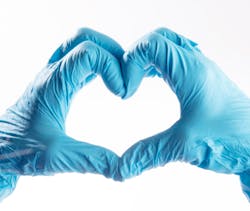What pandemic-inspired changes have stuck with your dental practice?
Back in the 1990s, when I started my hygiene career, I remember joking with patients that clinicians would be in spacesuits to protect us from pathogens one day. That comment feels almost prophetic given the changes we have embraced (or endured) with the COVID-19 pandemic. But, which of these changes are here to stay, and which ones will be discarded faster than you can say Porphyromonas gingivalis?
For those of us who are more “seasoned” hygienists, these changes remind us of when the bloodborne pathogens standard came into place in the early ’90s.1 It’s hard to believe, but there was a time we didn’t wear gloves and masks, and we wiped things down with alcohol-saturated 2x2s. The transition was tough for some of us, but the patients adjusted, and so did we.
More by Amanda Hill:
- Embrace the suck (or…the suction)
- The dental hygiene products you need in 2022
- Chairside Impact: DentalPost.net
Heightened infection control
What have we learned from this latest health crisis? Once we got over the sting of being called “nonessential,” we focused on often-ignored infection control guidelines. If we are to be considered essential health-care professionals, we need to stop squabbling over whether something is a guideline or a mandate and act responsibly on behalf of our patients and our team.
Many of us took our personal protective equipment (PPE) up a notch, donning surgical caps and face shields. After seeing how much stuff landed on my face shield, those two are here to stay.
The importance of HVE
Speaking of our health, using high-volume evacuation (HVE) suction in the hygiene room should be standard. While this seemed like news, it has been in the literature for a long time. Way back in the ‘60s, there was talk about using HVE and prerinses.2 Then, in 2004, Harrell and Molinari found that the use of HVE reduced contamination by more than 90%. They pointed out that for hygiene procedures, “this is of particular concern owing to the fact that periodontal procedures always are performed in the presence of blood and instruments such as the ultrasonic scaler, which has been shown to create the greatest amount of aerosol contamination, are used.”3 So, how can we safely and effectively incorporate HVE into hygiene appointments without growing a third arm?
Many new HVE products have come onto the market recently, and some are more effective than others. An important aspect to look for is the size of the opening. It needs to be a minimum of 8 mm wide to properly contain aerosols. Otherwise, it’s only controlling fluid.
Is there a built-in backflow preventer? We all know that patients can’t resist closing their mouths on the suction. Look at the instructions for use (IFU) for reprocessing when choosing a device. Should it be disassembled between each patient? Did you know that we’re supposed to take apart suction valves to properly clean and disinfect? I had no idea. Check your IFUs and appoint someone to manage that task.
I have found great success with the Dove Aero HVE Wide Mouth valve. It has a 22 mm wide-mouth swivel opening for excellent retraction. It’s lightweight, has a built-in backflow preventer, and is disposable for easy infection control. My cohygienist prefers the Dove Aero HVE saliva ejector. It combines a saliva ejector with HVE aerosol capturing and a backflow preventer. It is also single-use for patient safety, because no one in our office has time for taking things apart between patients!
Lasting improvements
It’s time our industry acts responsibly and mandates safety. What can we incorporate into our day to keep both our patients and ourselves safer? In another 30 years, I wonder if we’ll look at the pandemic’s changes and wonder how we ever practiced without them.
Editor's note: This article appeared in the July 2022 print edition of RDH magazine. Dental hygienists in North America are eligible for a complimentary print subscription. Sign up here.
References
- Denault D, Gardner H. OSHA Bloodborne Pathogen Standards. In: StatPearls. Treasure Island (FL): StatPearls Publishing; April 14, 2022.
- Micik RE, Miller RL, Mazzarella MA, Ryge G. Studies on dental aerobiology. I. Bacterial aerosols generated during dental procedures. J Dent Res. 1969;48(1):49-56. doi:10.1177/00220345690480012401
- Harrel SK, Molinari J. Aerosols and splatter in dentistry: a brief review of the literature and infection control implications. J Am Dent Assoc. 2004;135(4):429-437. doi:10.14219/jada.archive.2004.0207
About the Author

Amanda Hill, BSDH, RDH, CDIPC
Amanda Hill, BSDH, RDH, CDIPC, is an enthusiastic speaker, innovative consultant, and award-winning author who brings more than 25 years of clinical dental hygiene and education to dentistry. Recipient of ADS’s Emerging Infection Control Leader award and an active participant with the advisory board for RDH magazine, DentistryIQ, and ADS’s Infection Control in Practice Editorial Review Board and membership committee, Amanda (also known as the Waterline Warrior) strives to make topics in dentistry accurate, accessible, and fun. She can be reached at [email protected].
